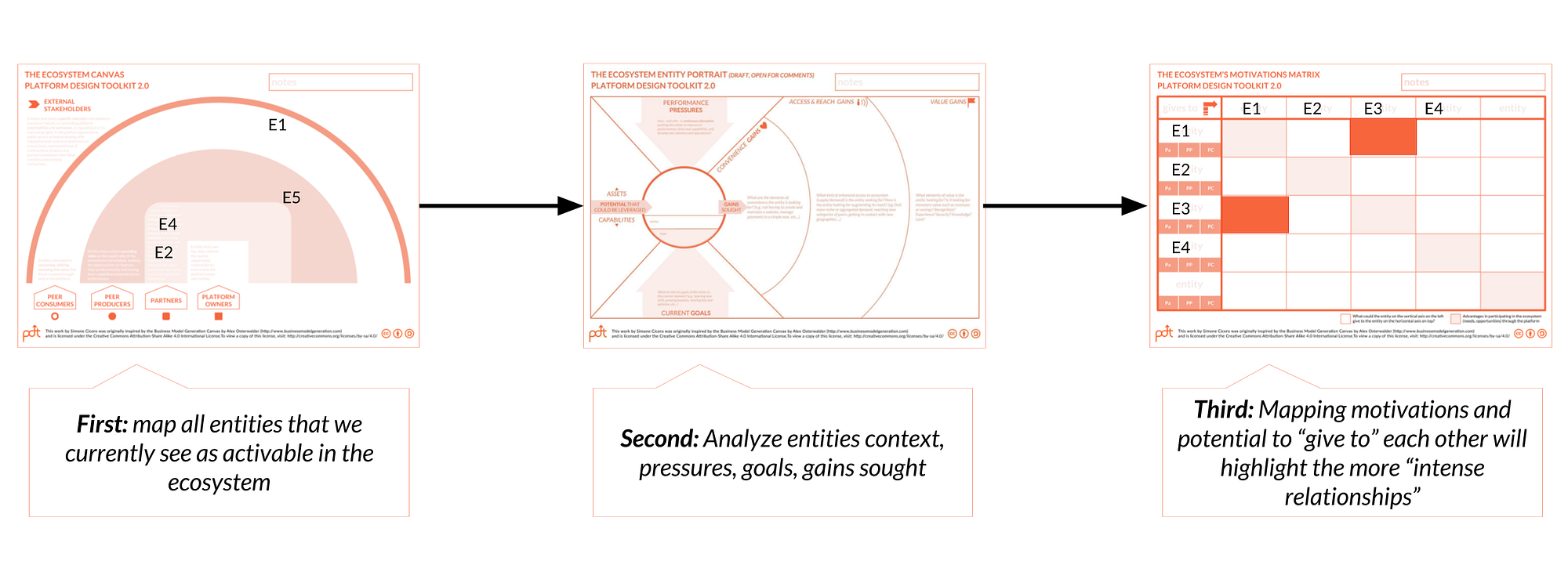Designers around the world are used to approach the design process with a User (Human) Centered point of view. Beyond the design community, other approaches to product design and development (think all the lean startup and customer development inspired tradition) have always been focused on customer centricity. Most of these approach are heavily attached to the customer narrative: one where the designer, the creator, is bounded to solve a customer problem, find the right market price of the solution, and scale. We believe that is time to deliberately focus on designing for interconnectedness, and that this will help organizations climb the value chain towards ecosystem actualization. (Thanks Eugenio Battaglia for the precious review).
We’ve been already praising the idea of moving past the customer narrativeon this blog in the past, and the latest months of intense platform design toolkit adoption with partners and customers, at masterclasses and beyond, pushed us to rethink and focus more on this. Beyond the original idea of moving from customer centered design to ecosystem centered design, we confronted the idea of human centricity with the much broader idea of relationships centricity.
Beyond a narrative of isolation
Let’s make it clear: customer (user) centric design created a narrative of isolation.
The customer is seen as someone that is provided with a solution to her problem, a solution that she needs to understand as something better than what she’s using at the moment to get the job done. In this narrative, the customer needs to embrace our solution, and consume it happily.
Despite research such as that of Eric Von Hippel explained that customers (users) may often look to engage more deeply with products, transforming and adapting them thanks to “user innovation toolkits”, in this outdated narrative, customers often look all the same and all behave independently, isolated from each other.
Relationship Centered Design
In our practice of platform design we’re increasingly discovering that relationships — between entities in the ecosystem — represent a new focal point of the design process in what we call “Relationship Centered Design”.
In practical and methodological terms, we’re now increasingly following this path:
- map the ecosystem players through the Ecosystem Map (position, connection with the strategy);
- deeply analyze their context thanks to Entity Portraits (understand the pressure and goals they’re feeling, the gains they seek for);
- assess their capability and potential to exchange value between each other in the Motivations Matrix.

After these exploratory phases aiming to understanding the “emergence” of the ecosystem, similarly to when we look for problems in search for solutions, we look to the potential that can be expressed, in search of a platform. Here we can start to see how the most important relationships in the ecosystem look like, and what they are: the more value intense, the more worth sustainingand facilitating.
These relationships become then the core of our platform design process (which again is relationship centric): we consider relationships the “ancestors” of the platform experiences we want to design.
After this selection of the most intense relationships we normally proceed to build a platform experience prototype “around” the single relationship.
- examining all the potential elementary transactions/interactions to happen in each relationship (thanks to the Transactions Board);
- model the liminal steps of learning (through the Learning Experience Canvas) needed to go through the onboarding– getting better–catching new opportunities process;
- put pieces together in a platform experience;
We always reflect deeply on the balance that every platform experience offers, between what we call “platform to peer” elements (industrial) and “peer to peer” (relational, post industrial) elements: we always encourage designers to increase and put a special focus on relational elements vs industrial, centralized, brand provided ones, for many reasons.
To learn more, please visit: Platform Design Toolkit



